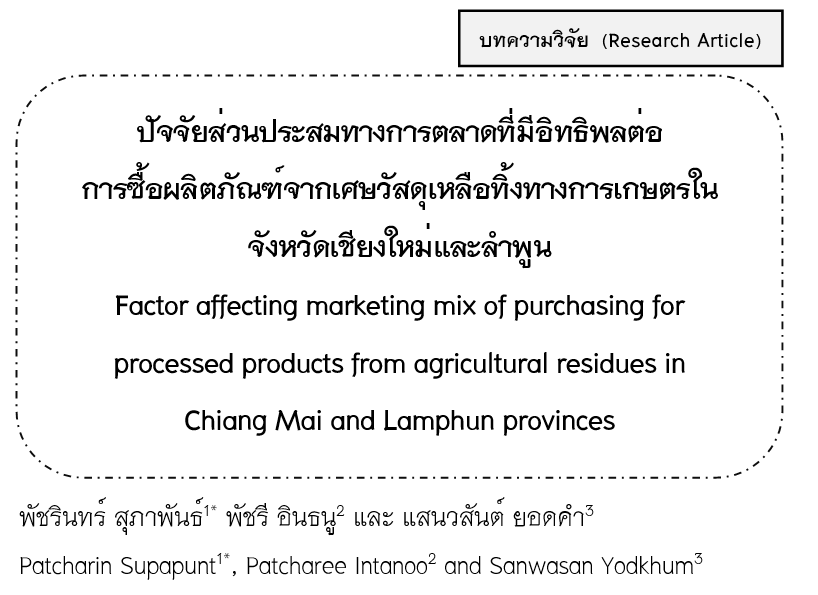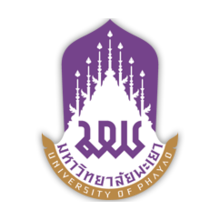Factor Affecting Marketing Mix of Purchasing for Processed Products from Agricultural Residues in Chiang Mai and Lamphun Provinces
Keywords:
Marketing Mix, Repurchasing, Product, Agricultural ResiduesAbstract
The objective of this study was to factor affecting marketing mix of purchasing for processed products from agricultural residues in Chiang Mai and Lamphun provinces according to marketing mix theory by means of multinomial logit model. The samples of this study were randomized by Taro Yamane table and purposive sampling. Data were collected in the form of interviews with questionnaires from 408 customers who were shopping in agricultural input shops and production sources of the products. Results revealed that the quality products contributed to an increase probability for customers to purchase organic fertilizers and growing media at a significant level of 0.10 and 0.05, respectively. Similarity, the complete detail product and brand certification on packages and distance from production source to markets resulted in an increase of the probability for growing media at a significant level of 0.10 and 0.05, respectively. Regarding a decreased probability, the portable products for organic fertilizers were comfortable at a significant level of 0.01. The promotion including discount, exchanging, free distribution, test, and public relation by government also associated with the decreased probability of organic fertilizers at a significant level of 0.10 and 0.05, respectively. Meanwhile, attraction on package and travel convenience to purchase decreased the probability of growing media at a significant level of 0.10 and 0.05, respectively. These factors of marketing mix should be considered carefully when producers must perform. It indicated that the factors affected to a different purchasing. Therefore, the factor increasing the probability should be maintained, while some factors should be improved or avoided leading to competitive advantages in the market.
References
กรมการปกครอง. (2562). สถิติจำนวนประชากร. สืบค้น 5 พฤษภาคม 2563, จาก https://stat.bora.dopa.go.th/stat/statnew/statMONTH/statmonth/#/displayData.
กรมควบคุมมลพิษ. (2563). สถานการณ์และการจัดการปัญหามลพิษทางอากาศและเสียงของประเทศไทย. กรุงเทพฯ: บริษัท ฮีซ์ จำกัด.
กรมควบคุมมลพิษ. (2562). แผนปฏิบัติการขับเคลื่อนวาระแห่งชาติ “การแก้ไขปัญหามลพิษด้านฝุ่นละออง”. สืบค้น 17 มีนาคม 2563, จาก http://air4thai.pcd.go.th/webV2/download.php.
เกศรา จันทร์จรัสสุข. (2555). ปัจจัยที่มีอิทธิพลต่อพฤติกรรมการซื้อสินค้าและบริการในห้างเทสโก้โลตัสของผู้บริโภคในกรุงเทพมหานคร. (วิทยานิพนธ์บริหารธุรกิจมหาบัณฑิต). กรุงเทพฯ: มหาวิทยาลัยศรีนครินทรวิโรฒ.
จำเนียร บุญมาก และ จุรีภรณ์ อุทธิ. (2556). การพัฒนาบรรจุภัณฑ์ข้าวกล้องอินทรีย์ของสหกรณ์เกษตรอินทรีย์เชียงใหม่ จำกัด. วารสารวิชาการและวิจัย มหาวิทยาลัยเทคโนโลยีราชมงคลพระนคร, 1(2556), 38-47.
จิตราภรณ์ วันใจ. (2548). ปัจจัยส่วนประสมทางการตลาดที่มีผลต่อการตัดสินใจจัดจำหน่ายยาสมุนไพรไทยของผู้ประกอบการร้านขายยา จังหวัดเชียงราย. (การศึกษาอิสระบริหารธุรกิจมหาบัณฑิต). เชียงราย: มหาวิทยาลัยราชภัฏเชียงราย.
ชัชวาลย์ เรืองประพันธ์. (2543). สถิติพื้นฐานพร้อมตัวอย่างการวิเคราะห์ด้วยโปรแกรม Minitab SPSS และ SAS. ขอนแก่น: มหาวิทยาลัยขอนแก่น.
นัทธ์หทัย ศิริวิริยะสมบูรณ์ ธำรง เมฆโหรา และทิพวรรณ ลิมังกูร. (2555). ปัจจัยที่มีผลต่อการยอมรับการปลูกผักปลอดภัยจากสารพิษของเกษตรกรในอำเภอบางใหญ่ จังหวัดนนทบุรี. วารสารเกษตรพระจอมเกล้า, 30(2), 59-67.
นารีรัตน์ ฟักเฟื่องบุญ. (2554). ปัจจัยทางการตลาดที่มีผลต่อพฤติกรรมการตัดสินใจเลือกซื้อสินค้าของผู้บริโภคในศูนย์จำหน่าย เอส.บี. ดีไซด์สแควร์ในเขตกรุงเทพมหานคร. (วิทยานิพนธ์บริหารธุรกิจมหาบัณฑิต). กรุงเทพฯ: มหาวิทยาลัยศรีนครินทรวิโรฒ.
เยาวรัตน์ ศรีวรานันท์. (2554). ความเต็มใจจ่ายของผู้บริโภคในจังหวัดขอนแก่นที่มีต่อเนื้อสุกรอินทรีย์. วารสารเศรษฐศาสตร์และนโยบายสาธารณะ, 7(7), 1-24.
ศรีเวียง ทิพกานนท์, รัชนี เจริญ, วรรณทิชา เศวตบวร และวิ บูลย์ เหรียญสง่าวงศ์. (2561). การสร้างแนวคิดผลิตภัณฑ์เครื่องดื่มจมูกข้าวสำหรับผู้สูงอายุในจังหวัดปราจีนบุรีโดยใช้วิธีการวิเคราะห์องค์ประกอบร่วม. Kasetsart Journal of Social Sciences, 39(1), 674-683.
ศิริวรรณ เสรีรัตน์. (2546). การบริหารการตลาดยุคใหม่. กรุงเทพฯ: ธรรมสาร.
สณัฐวีย์ น้อยโสภา. (2558). เกษตรอินทรีย์ โอกาสการส่งออกของเกษตรกรไทยในตลาดโลก. วารสารวิชาการ มหาวิทยาลัยธนบุรี, 9(18), 83-91.
สัมฤทธิ์ กางเพ็ง, สรายุทธ กันหลง และ ดุษฎีวัฒน์ แก้วอินทร์. (2559). การวิจัยแบบผสมวิธี: กระบวนทัศน์การวิจัยในศตวรรษที่ 21. มหาสารคาม: ห้างหุ้นส่วนจำกัด อภิชาติการพิมพ์.
สามารถ ใจเตี้ย. (2563). การใช้ประโยชน์วัสดุเหลือใช้ทางการเกษตรของเกษตรกรในเทศบาลตำบลขี้เหล็ก อำเภอแม่ริม จังหวัดเชียงใหม่. วารสารวิจัยและส่งเสริมวิชาการเกษตร, 38(2), 79-88.
สำนักงานเศรษฐกิจการเกษตร. (2564). สถิติการเกษตรของประเทศไทย ปี 2564. สืบค้น 20 ธันวาคม 2565, จาก https://www.oae.go.th/assets/portals/1/files/jounal/2565/yearbook2564.pdf.
สำนักงานสภาพัฒนาการเศรษฐกิจและสังคมแห่งชาติ. (2564). (ร่าง) แผนพัฒนาเศรษฐกิจและสังคมแห่งชาติฉบับที่ 13. สืบค้น 10 ธันวาคม 2565, จาก https://www.nesdc.go.th/download/document/Yearend/2021/plan13.pdf.
สุธีระ บุญญาพิทักษ์. (2564). ปัจจัยการจัดการวัสดุเหลือใช้ทางการเกษตรของเกษตรกรเพื่อลดการเผา กรณีศึกษา อำเภอบ้านไผ่ จังหวัดขอนแก่น. (วิทยานิพนธ์วิทยาศาสตรมหาบัณฑิต). กรุงเทพฯ: สถาบันบัณฑิตพัฒนบริหารศาสตร์.
สุรชัย จันทร์จรัส พงศธร ชัยสวัสดิ์ และ อโณทัย หาระสาร. (2559). อุปสงค์การกลับมาเที่ยวซ้ำและการเลือกที่พักของการท่องเที่ยวจังหวัดน่าน. วารสารมหาวิทยาลัยศิลปกร, 36(1), 25-48.
เสาวภา พิณเขียว และนภวรรณ ตันติเวชกุล. (2560). การสื่อสารความเป็นตราสินค้าระดับโลกของตราสินค้าระดับโลกและตราสินค้าท้องถิ่นในประเทศไทย. วารสารบริหารธุรกิจ เศรษฐศาสตร์และการสื่อสาร, 12(2), 93-109.
หนังสือพิมพ์เนชั่น. (2552). เพิ่มมูลค่าด้วยบรรจุภัณฑ์. สืบค้น 2 กรกฎาคม 2563, จาก http://oknation.nationtv.tv/blog/packaging/2009/10/17/entry-1.
อารี วิบูลย์พงศ์. (2547). เศรษฐมิติประยุกต์สำหรับการตลาดเกษตร. เชียงใหม่: มหาวิทยาลัยเชียงใหม่.
Akgün, A. E., Keskin, H., & Ayar, H. (2014). Standardization and Adaptation of International Marketing Mix Activities: A Case Study. Social and Behavioral Sciences, 150(2014), 609–618.
Huang, R. & Sarigöllü, E. (2012). How brand awareness relates to market outcome, brand equity, and the marketing mix. Journal of Business Research, 65(1), 92–99.
Kamsuwan, O. (2015). How Promotion at 7-Eleven Influences to Customer Purchasing. (Thesis of Master of Business Administration), Bangkok: Bangkok University.
Kotler, P. & Armstrong, G. (2001). Principles of Marketing (9th Ed.). New Jersey: Prentice Hall Incorporate.
López-Ospina, H., Agudelo-Bernal, A., Reyes-Muñoz, L., Zambrano-Rey, G., & Pérez, J. (2021). Design of a location and transportation optimization model including quality of service using constrained multinomial logit. Applied Mathematical Modelling, 89(2021), 428–453.
Mahapatra, K. & Kant, S. (2005). Tropical deforestation: a multinomial logistic model and some country-specific policy prescriptions. Forest Policy and Economics, 7(2005), 1–24.
Michella, P., Lyncha, J., & Alabdalib, O. (1998). New perspectives on marketing mix programme standardization. International Business Review, 7(6), 617-634.
Obi, F.O., Ugwuishiwu, B.O., & Nwakaire. J. N. (2016). Agricultural wastes concept, generation, utilization and management. Nigerian Journal of Technology, 35(4), 957-964.
Sheau-Ting, L., Mohammed, A. H., & Weng-Wai, C. (2013). What is the optimum social marketing mix to market energy conservation behavior: An empirical study. Journal of Environmental Management, 131(2013), 196–205.
Torres, M., Hervas, C., & Garcia, C. (2009). Multinomial logistic regression and product unit neural network models: application of a new hybrid methodology for solving a classification problem in the livestock sector. Expert Systems with Application, 36(2009), 12225–12235.
Wasi, N. (2017). Economist and choice behavior forecast. Retrieved August 16, 2021, From https://www.pier.or.th/?abridged.

Downloads
Published
How to Cite
Issue
Section
License
Copyright (c) 2023 Phayao University

This work is licensed under a Creative Commons Attribution-NonCommercial-NoDerivatives 4.0 International License.
ผู้นิพนธ์ต้องรับผิดชอบข้อความในบทนิพนธ์ของตน มหาวิทยาลัยพะเยาไม่จำเป็นต้องเห็นด้วยกับบทความที่ตีพิมพ์เสมอไป ผู้สนใจสามารถคัดลอก และนำไปใช้ได้ แต่จะต้องขออนุมัติเจ้าของ และได้รับการอนุมัติเป็นลายลักษณ์อักษรก่อน พร้อมกับมีการอ้างอิงและกล่าวคำขอบคุณให้ถูกต้องด้วย
The authors are themselves responsible for their contents. Signed articles may not always reflect the opinion of University of Phayao. The articles can be reproduced and reprinted, provided that permission is given by the authors and acknowledgement must be given.







